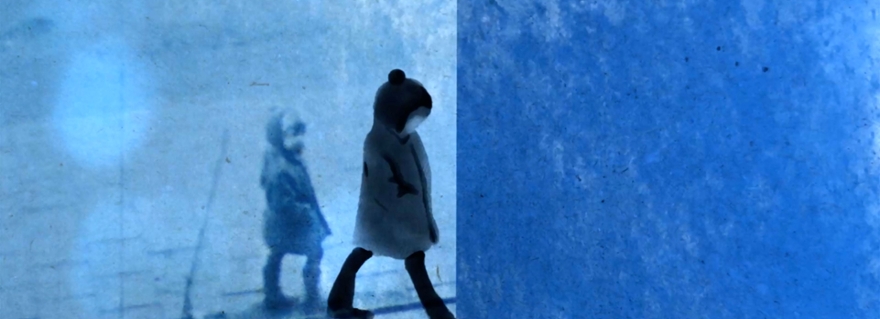
'Children are too seldom seen as victims of femicide'
What do we know about the children left behind after (ex-)partner homicide? Director Sara Kolster and professor Marieke Liem joined forces to bring this group of victims into view through the moving documentary ‘Blauwdruk’ and new data from the Femicide Monitor.
On 25 November, the Orange the World campaign against violence towards women and girls begins. At Wijnhaven, we will screen the HUMAN documentary 'Blauwdruk', created by director Sara Kolster together with lived-experience expert Perla Joy. For this documentary, Sara reached out to professor Marieke Liem to ask whether we know how many children are left behind after (ex-)partner homicide. What is the impact on this group?
In an open conversation, Sara and Marieke discuss the relationship between film and research, the attention given to children who are left behind, and the societal change that is needed.

How did you come into contact with one another?
Sara: ‘While working on the documentary, I contacted Marieke because Perla and I were struggling with the terms femicide and partner homicide. What do these terms really mean, and when should they be used?’
Marieke: ‘Yes, the term femicide was just emerging at the time – the killing of women because they are women. I felt we needed to be cautious in using the term, because the killing of women encompasses far more than the prototype of ‘man abuses, stalks and murders his ex-wife’. I had written a critical piece about the term because, from a scientific perspective, it’s difficult to prove: the killing of a woman solely because she is a woman. How do you substantiate that?’
So caution remains necessary.
Marieke: ‘Yes. In academic terms, we call it female homicide, because that can be measured. At the same time, we use the term Femicide Monitor to align with international initiatives and because of the recognition the term has acquired.’
Sara: ‘It remains important to ensure that the term is used correctly. The four women in 'Blauwdruk' all experienced the killing of their mother by a partner in very different ways. One of them, despite her father threatening her mother, still has fond memories of him. You see how complex these situations are. You can’t simply apply one label to them.’

In ‘Blauwdruk’, these women reconstruct their childhood homes using tape. Why did you choose that form, Sara?
Sara: ‘During my training in grief counselling for children, I once did an exercise where I had to mentally return to my childhood home. It brought back both pleasant and painful memories. The home often symbolises the family and childhood memories which is a private space where one is usually safe. But in the homes featured in the documentary, the very worst has taken place. I see the home as a blueprint of the family and of the trauma that forms there.’
Four women, four stories , there’s enormous depth in that. How do you translate that into data for research, Marieke?
Marieke: ‘Sara’s documentary beautifully shows that complexity. In our research, we look for clusters. Despite all the different stories, certain patterns emerge. We want to look beyond the narrative of intimate terrorism, and also take into account issues such as guilt, mental health problems, gender and status differences, and the social environment. So even though we combine the data, we always try to avoid oversimplification.’
Sara: ‘While making the documentary, I asked Marieke about recent figures on children left behind after femicide. These data weren’t yet included in the Femicide Monitor, so Marieke and her team started investigating. We were all shocked to discover how many children are affected each year.’
Children left behind after (ex-)partner homicide
The Dutch Femicide Monitor was updated on 5 November 2025 to include data on children whose mother was killed by a male (ex-)partner. Nearly two-thirds of the victims had children, who are often insufficiently protected afterwards. One in ten children is also a fatal victim, and in almost half of the cases, children were (in)direct witnesses. The figures can be found in the factsheet ‘Onzichtbare Slachtoffers’ .
How do you view the relationship between film and research?
Marieke: ‘I find it incredibly valuable, and I’m grateful that Sara wants to show this. As researchers, we can’t present individual stories so openly. We’re bound by ethical guidelines and the duty to ensure anonymity. We need journalists, documentary makers and theatre makers to bring out those personal narratives.’
Sara: ‘I hope that through the documentary, the children’s perspective will be recognised and that people will see the world behind media headlines. Entire families are torn apart, and in our society, more than just the police and the justice system are confronted with this issue. This insight is important because these stories take place behind closed doors. By sharing them, we hope more people will feel compelled to speak out and show vulnerability.’
Marieke: ‘With the documentary and our research, we shine a light on an invisible population. Children are often treated by the system as witnesses, but too rarely seen as victims, even though that’s exactly what they are. It’s good that this is getting attention.’
The HUMAN documentary ‘Blauwdruk’ will be broadcast on Thursday 20 November at 22:20 on NPO 2 and NPO Start. Following the documentary, a series of intimate film screenings are featured with discussions featuring lived-experience experts afterwards. At blauwdruk.org new data will be visualised and given broader context in 2026 by director Sara Kolster and lived-experience expert Perla Joy.
